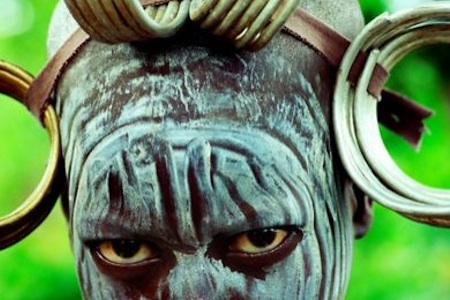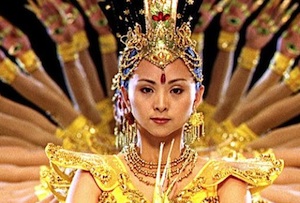
It’s unlikely that any contemporary filmmaker has racked up more frequent-flyer miles than Ron Fricke. As co-writer and cinematographer of Koyaanisqatsi, Godfrey Reggio’s groundbreaking impressionistic documentary depicting ‘life out of balance’ across a wide and worrisome world, and as director of the similarly expansive Chronos and Baraka, Fricke has established himself as a globetrotting visionary whose immaculate and truly awesome images—often seen in a hypnotic rush through his customary time-lapse photography—render the foreign familiar and the quotidian extraordinary. He’s been just about everywhere and no doubt has mastered the fine art of packing, though 70mm movie cameras don’t fit in most overhead bins.
Fricke continues his “family of man” tradition of filmmaking with Samsara, which opens this week in the U.S., titled from a Sanskrit word meaning ‘the ever-turning wheel of life’ and visualized through intricate sand paintings that are ritualistically made and then destroyed by Tibetan monks. Filmed over a period of five years, in 25 countries on five continents (no trips to Australia or Antarctica this time out), the film, like its predecessors, eschews dialogue and descriptive text in favor of a continuously flowing series of unadorned images among which viewers are encouraged to draw their own connections. Spewing volcanoes, sweeping sand dunes, solemn baptisms, stained-glass cathedrals, Hurricane Katrina wreckage, shantytowns, grimacing performance artists, masses of motherboards, big-box consumer gluttony, Yellowstone, the Palace of Versailles, backbreaking labor, indoor driving ranges, rosy-cheeked teens proudly bearing arms…it’s all here, and through the rhythmic editing and deliberate juxtaposition of these images, viewers are witness to—and not a little responsible for—every nook and cranny of this third rock from the sun. From the soaring peaks of Mt. Nemrut National Park in Adiyaman, Turkey, to the anthill-like scurrying of megalopolis commuters crushed by the wheels of industry, the scope of Fricke’s investigation of our natural splendor, late-capitalist folly and mystifying worldly affairs is daunting, often alarming yet also divine. Samsara is a travelogue like no other, one guided by a moral compass and soundtracked with gorgeous music featuring the otherworldly Lisa Gerrard of Dead Can Dance.
Joined by longtime producing partner Mark Magidson, Fricke recently shared stories of journeys and destinations via a phone conversation in which the pair’s oft-professed commitment to their craft and belief in human and harmonic interdependence rang true.
Keyframe: Another film, another years-long trip around the world, away from family, friends and any semblance of stability. What motivates you to embark on these adventures, even knowing that logistic hardship awaits?
Ron Fricke: There’s just something so deeply satisfying about going out into the world with a 70mm camera, working with it and trying to capture the essence of things. It’s a great experience all the way through, from shooting on location to assembling the film in the cutting room. I’ve always been inspired to do it. It’s like painting for me.
Mark Magidson: These projects require so much work and effort and energy, and you really don’t want to come back home with any regrets, so once we start we really go all out. When we finish, we want to feel like we’ve given it our all. It is strange, though, to see your five years of work condensed into a 100-minute film. Where did all the time go?

Keyframe: I don’t suppose you get many chances for retakes.
Fricke: True, but we try to leave a door open, and about a year into the editing process we were able to take a break and go back for a couple of pickup shots.
Keyframe: I’m guessing your shooting ratio is far lower than on most feature films, and that the cutting-room floor isn’t littered with too much unused footage.
Fricke: Not much was been left out because we don’t roll the camera if we know in our gut that a setup won’t work within our concept. It’s not like shooting digitally, when you can just fire away and gather as much footage as you want. It’s pretty tough to move around a 70mm camera, and it’s expensive to shoot this way. We just stick to our process of carefully and methodically capturing the imagery we want the most.
Keyframe: Lugging around the 70mm equipment must be a burden at times. Do you ever have moments of envy for your peers who shoot digitally, lightweight and with a skeleton crew?
Fricke: It’s not all that different. We were a teeny-tiny crew running around just like those filmmakers, but with heavier equipment!
Magidson: It’s truly a privilege to shoot in this film stock.
Fricke: I agree. The content of the film was revealed in the gorgeous negative, and there’s so much depth and fidelity. After all, the main character in our films is the image itself.
There are a lot of great filmmakers out there now. James Cameron shows us things we’ve never seen before. Coppola, Lucas…the list is endless. I grew up looking at Bergman and Fellini, and was inspired by David Lean, especially the way he utilized landscapes. Kubrick’s ‘2001: A Space Odyssey’ was amazing at the time, with its 40 minutes of nonverbal footage in a Cinerama movie.
Keyframe: The notion of the samsara, or wheel of life, painstakingly assembled then brushed away, is an effective metaphor throughout the film. How did this concept develop as a guiding principle?
Fricke: We started with the concept, and knew that we wanted to bookend the film with scenes of the sand painting mandala. Once we had those scenes established, we took a Zen approach to editing, cutting sequences into small thematic blocks without music or sound. The images drove their own order; we call this a guided meditation approach to editing.
Keyframe: Werner Herzog also used the sand mandala as a visual metaphor in Wheel of Life, his 2003 documentary on Tibetan Buddhism. Herzog has traveled to far-flung locales numerous times for his films, just as you have. Is Herzog a touchstone for you, and have any other filmmakers been particularly influential?
Fricke: Herzog, sure. There are a lot of great filmmakers out there now. James Cameron shows us things we’ve never seen before. Coppola, Lucas…the list is endless. I grew up looking at Bergman and Fellini, and was inspired by David Lean, especially the way he utilized landscapes. Kubrick’s 2001: A Space Odyssey was amazing at the time, with its 40 minutes of nonverbal footage in a Cinerama movie.
Keyframe: There are no man-apes in Samsara, but the film does in certain ways suggest 2001’s thematic scope and enduring mystery. As in your past films, you show us a staggering array of locations and cultures without identifying places or names until the end credits. Why withhold information that would likely provide viewers with more concrete context for your images?
Magidson: We’ve always been wary of taking viewers away from an inner-feeling state or toward an intellectual state in which the images cease to operate with primal power. We both understand that many viewers will be curious as they watch the film. ‘Is that Brazil? Now are we in the Philippines?’ It’s fine to wonder, but the main thing is for us to maintain that inner-feeling state of mind.
Fricke: Our overriding concept is the sense of flow and interconnectedness that we feel as we visit these different locations and cultures, so in both the shooting and editing stages we try to steer down the middle, to depict global flow and how we’re all connected rather than merely make a documentary about a bunch of different places.
Keyframe: That sense of flow is evident in your editing choices, yet to my eyes there’s also an underlying critique of the many ways in which we as inhabitants of this planet have interrupted the natural order of things. For example, you juxtapose pristine landscapes in Monument Valley, or the Epupa Falls in Angola—places that summon wonderment—with sequences depicting the insane bustle of big-city life or the manufacturing of custom-made coffins in the shape of giant guns. Where have we gone wrong, and can we find our way back to that often elusive interconnectedness?
Fricke: The way I see it, we’ve all been invited to this planet. You could say life invited us here and didn’t ask any of us to approve of the guest list. So here we are, all together. The most powerful images tend to depict those moments when the flow is interrupted: animals in cages, people in prisons, walls around religions, dolls that replicate life. We feel that we have to show many sides of human experience, but again, it’s not for us to say what’s good and what’s bad. Take the housing developments in Dubai; they’re visually impressive, and it’s fascinating for us to see how people live in other parts of the world, but we’re not making absolute judgments. The sex dolls, the dancers in Thailand…these are elements of the human condition. The world is about much more than beautiful landscapes.
Keyframe: Can you talk about your use of the human face, images of which you return to repeatedly throughout the film?
Fricke: At the beginning of the film we take a close look at King Tut’s death mask, and following that we included many portraits of faces staring directly into the camera. The human face is a timeless image, and for us it is one of the most effective visual motifs for conveying the sense of flow and interconnectedness that guides the entire film.
Keyframe: Toward the end of the film you zoom out from the intimacy of a single face to encompass the teeming mass of humanity—from the self to the society—most strikingly in the Mecca sequence, with millions of believers making the pilgrimage to the Masjid al-Haram. What was it like to be in the midst of such spiritual fervor?
Fricke: We almost didn’t get that sequence. It was our first international location, and we traversed this large network of underground tunnels to get to the best vantage points from which to shoot. We managed to make it up to the fortieth floor of the Bin Laden tower for this amazing aerial view. Our local fixer had gained permission from the building’s security staff, but not from the owners, a very powerful family. So we’re up there, during Ramadan, with two million pilgrims in and around the mosque, and we’re filming all night. Suddenly the family arrives and wants to throw us out. We talked to them, told them, ‘This is beautiful! The world should see this!’ We waited out a long pause. Finally, the family told us we were welcome to stay, and we got the footage that’s in the film.
Magidson: All of the other locations were easier than this first one. We always worked out our plans ahead of time, and locals were happy to see us when we arrived. The only place on our wish list that we couldn’t get to was North Korea. We wanted to film this mass performance that the North Koreans take part in every year; thousands of people perform a dance straight out of a Busby Berkeley musical. We just couldn’t make it happen.
Keyframe: Maybe you’ll try again, in another ten years or so?
Fricke: Probably sooner than that. We’re not getting any younger!




